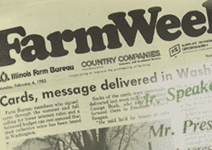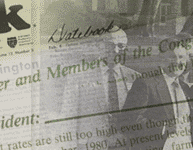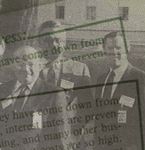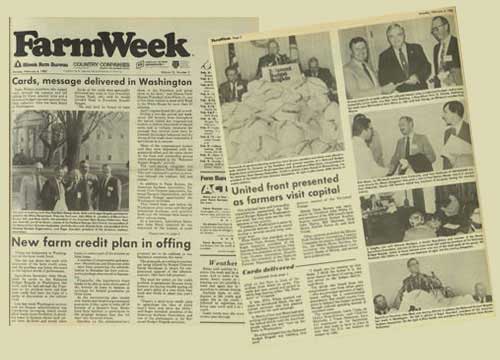 |
 |
 |
| The
Power of Association |
| Introduction / Chinch Bugs / Farm Bureau Serum Association / Rural Roads / Agriculture in the Classroom / Taxes / Federal Budget / Other Examples / Conclusion / Notes |
In 1831, French aristocrat Alexis de Tocqueville traveled in the United States on a mission of observation for the government of France. He compiled his findings into a two-volume work titled Democracy in America. In those books he wrote,
He further wrote,
de Tocqueville foreshadowed what was to come in the agricultural community some 80 years later with the advent of county Farm Bureaus. He continues,
I
would contend the Illinois Farm Bureau does that and does it very well.
Its efforts are made ever stronger because of the power of association.
That power is redoubled when the partnership of county and state organizations
is directed toward an issue. Further, the organization remains strong
because it has listened to the needs of its members. I believe this is
best illustrated by taking a look at some of the programs throughout the
years that had their origins in the counties. Let’s take a look
at programs that had their genesis in the counties, but brought together
the combined strength and numbers of the county and state organizations.
|
One of the earliest examples of “the power of association” is found in the war on chinch bugs. From the earliest days of ‘scientific’ farming through the 1940s, chinch bugs proved an elusive enemy. Dorothy Noel shares her remembrances of those years as a 12-year-old girl:
|
|
An early control for the pest was the application of a creosote barrier
along the edge of a field to turn back the migrating insects. They would
then be directed into post holes filled with calcium cyanide. This control
method was developed in Illinois and carried throughout the state, indeed
the entire Midwest, by the network of county agents, which were on staff
of the various county Farm Bureaus.
There
is also anecdotal evidence that anyone bringing a quart of chinch bugs
could gain free admission to the 1933 World’s Fair & Exposition
in Chicago. |
|
|
Another
example of this power of association is found in the realm of animal health
products. In 1915, Hancock County Farm Bureau entered into a cooperative
buying program for serum vaccine for hogs. As other counties joined in,
the Illinois Farm Bureau Serum Association was formed in 1924. |
The
issue of good rural roads has been one of the most important issues that
Farm Bureau has worked on throughout its history. In the 1920s the problem
of poor farm-to-market roads was prominent in Farm Bureau policy. That
policy focused both on road quality and road funding. Twenty years later
Farm Bureau saw its efforts in local road funding bear fruit when then-Governor
Adlai Stevenson signed into law a bill that would channel a portion of
the state’s gasoline tax to local road improvement. |
We usually look to 1987 as the beginning of Farm Bureau’s ag literacy efforts to the non-farm public when two county Farm Bureaus, Grundy and Cook, established Agriculture in the Classroom programs. As early as 1921, however, we find evidence of a cooperative plan by the IAA, the county Farm Bureaus, and individual farmers to bring an understanding of agriculture to the city. The front page headline of the July 7th, 1921, I.A.A. News Letter reads “Farm Outing for Slums ‘Kids’ Planned by I.A.A.” The story reads,
|
|
|
|
|
The purpose for the outings, as stated in the article, is,
The focus of these programs was, and remains today, to take the message of agriculture into non-farm homes. Today that message is carried loud and clear through the organized efforts of 95 county Farm Bureaus and backed up with the support of staff at the Illinois Farm Bureau. |
|
The
decade of the ‘70s both began and ended with work on taxation. Farm
Bureau worked diligently to bring equity to the tax system for all taxpayers.
The IAA, county Farm Bureaus, and individual members worked together effectively
through both the legislative arena and court proceedings to make this
happen. Two county Farm Bureaus that figured prominently in this issue
were Henry and Lake. |
One
more example of the power of association is the work that was done in
the 1980s on the federal budget deficit and how it impacts net farm income.
While this issue may not seem to be one that would fall within the purview
of the counties, there was definitely work going on. |
|
|
|
|

FarmWeek coverage of the Budget Brigade’s trip to Washington, D.C. to deliver the 175,000 postcards signed by Illinois farmers who wanted Congress and the President to lower interest rates and cut the federal budget deficit. |
|
Time
or space will not permit a more detailed look at all of this cooperative
work of the associations, but let me briefly mention a few. |
So
what are we to learn from this power of association? Stephen Lamb asked
recently, in an article for Association Management magazine,
“If our Association did not exist, would someone invent it?”
I believe the answer to that is a resounding, “Yes!” Are our
members better off through their association with one another? Again,
“Yes.” The answers are unashamedly, “Yes,” because
Farm Bureau has remained relevant to the needs of its members. |
1. |
Alexis de Tocqueville, Democracy in America, Book I, Charles Gosselin, Paris, 1835, Chap. XII, “Political Associations in the United States.” |
|
2. |
Alexis de Tocqueville, Democracy in America, Book II, Charles Gosselin, Paris, 1840, Chap. V, “Of the Use Which the Americans Make of Public Associations in Civil Life.” |
|
3. |
John J. Lacey, Farm Bureau in Illinois, Illinois Agricultural Association, Bloomington, Illinois, 1965. |
4. |
Dan Leifel and Norma Maney, The Diamond Harvest: A History of the Illinois Farm Bureau, Illinois Agricultural Association, Bloomington, Illinois, 1990. |
5. |
Stephen L. Lamb, CAE, “Purposefully Providing Value,” Association Management, December 2003, pp. 36-38. |
6. |
Donald A. Ritchie, “Interview #1: From Illinois to Oxford”, United States Senate Historical Office – Oral History Project, www.senate.gov. |
7. |
“Farm Outing for Slums “Kids” Planned by I.A.A.”, I.A.A. News Letter, Illinois Agricultural Association, Chicago, No. 60, July 7, 1921. |
8. |
Dorothy Noel, “When I Was Twelve”, Scrapbook Memories, Kansas City Public Library Special Collections, www.kclibrary.org/sc/history/1000stories/scrapbook/noel.htm. |
9. |
“Cards, message delivered in Washington”, FarmWeek, February 4, 1985, pp. 1-2. |
10. |
“1986 State News”, NWHS Class of ’86, Northwestern High School, Rock Hill, SC, www.poag.net/nwhs86/state86.html. |